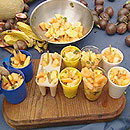Jackie French says that when you serve mint, don’t be boring! There are many different forms of mint available, all with their own distinctive flavours and uses.
Growing mint
The genus Mentha includes around 25 species of perennial and annual herbs from Europe, Asia and Africa. They are grown for their flavour, fragrance or ornamental appeal. They vary in size and appearance depending on the variety, but all contain volatile oils including menthol, which gives mint its typical taste and smell.
Mint thrives in rich, moist soil and a position in sun or part shade. Most mints are invasive and are best grown in a large pot or tub. They grow in all areas of Australia.
Types of mint
Jackie grows many different kinds of mint, including:
Eau de Cologne mint (Mentha x piperita f. citrata) has bronze purple leaves and a lavender-like aroma. Jackie uses it to make mint juleps. Eau de Cologne mint is an environmental weed in Victoria.
Lemon mint (Mentha x piperita f. citrata ‘Lemon’) has pink flowers and light green, lemon scented leaves.
Curly mint (Mentha spicata var. crispa) has pretty, crinkled leaves.
Orange mint (Mentha x piperita f. citrata ‘Orange’) has dark green leaves with purple edges, and a strong, orange flavour.
White peppermint (Mentha x piperita) is a vigorous grower with lilac-pink flowers. It makes a very good tea. It is an environmental weed in Victoria and Western Australia.
Stone mint (Cunila origanoides) has a fresh, minty flavour.
Chocolate mint (Mentha x piperita f. citrata ‘Chocolate’) doesn’t taste like an after dinner mint, but it does have a chocolate-peppermint scent.
Spearmint (Mentha spicata) makes the best mint tea of all. It is an environmental weed in Victoria and Western Australia
Apple mint (Mentha suaveolens). Also called woolly mint and round-leafed mint, this vigorous plant is invasive and should not be planted near bushland.
Ginger mint (Mentha x gracilis ‘Variegata’) has variegated leaves, and makes a warming tea for mid winter. It’s also good in fruit salad.
Fruit mint iceblocks
Kids love these frozen fruit treats after a hot day at school. Jackie also chops them up and serves them to adults in elegant wine glasses.
Ingredients
3 tablespoons of your favourite mint, chopped
1 pineapple, chopped
1 rockmelon, chopped
3 bananas, chopped
pulp of 10 passionfruit
sugar, to taste
Method
1. Put the mint, pineapple, rockmelon, bananas and passionfruit pulp into a large bowl. Add sugar to taste. (Note: the fruit salad may be sweet enough without sugar.)
2. Mix together thoroughly, then spoon into moulds (iceblock moulds are ideal, but plastic cups or styrofoam mugs can also be used).
3. Slip an iceblock stick into the middle of each mould. (Tip: use teaspoons if you don’t have iceblock sticks.)
4. Put the moulds into the freezer and leave for a couple of hours to set.
Further information
Mint is readily available from the herb section of your local nursery.



